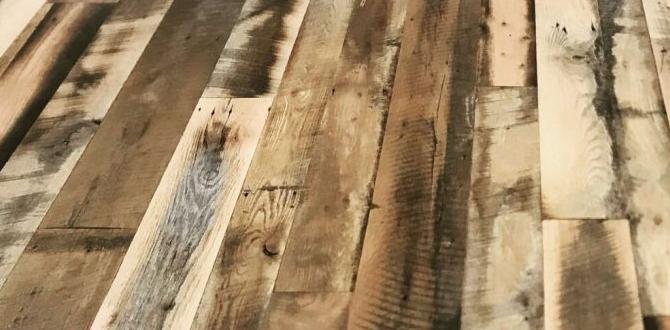Use a siding nailer like a pro! This guide covers setup, operation, maintenance, and safety for perfectly installed siding, making your DIY projects faster and easier.
Hey there, fellow do-it-yourselfers! Jack Shaffer here, your go-to guy at Nailerguy. Ever looked at a beautiful, seamlessly sided house and thought, “Wow, that looks tricky”? Or maybe you’re staring down your first big siding project and feeling a little overwhelmed by all the specialized tools? I get it. Installing siding can seem like a mountain to climb, especially when it comes to using specialized tools like the siding nailer. But guess what? It doesn’t have to be! With the right knowledge and a bit of practice, you can master this tool and achieve professional-looking results on your home improvement projects. We’re going to break down exactly how to use a siding nailer, step-by-step, making it simple and stress-free. Get ready to boost your confidence and your home’s curb appeal!
Table of Contents
What is a Siding Nailer and Why You Need One
So, what exactly is this magical tool, the siding nailer? Simply put, it’s a pneumatic (air-powered) nail gun specifically designed to drive nails into building siding quickly and efficiently. Unlike a standard framing nailer, siding nailers are built for the specific thickness and material of siding products, whether it’s wood, vinyl, fiber cement, or engineered wood like hardie board. Using a siding nailer significantly speeds up installation time compared to hand-nailing, and more importantly, it ensures consistent nail depth and placement, which is crucial for a weather-tight and attractive finish. Think of all the bent nails and sore thumbs you’ll save!
Types of Siding Nailers
Before we get nailing, it’s good to know there are a few types of siding nailers out there, each suited for different siding materials. Understanding these differences will help ensure you’re using the right tool for your job:
- Pneumatic Siding Nailers: These are the most common and powerful. They require an air compressorto operate. They drive nails quickly and consistently, making them ideal for large projects and all types of siding, especially harder materials like fiber cement.
- Cordless Siding Nailers: These offer great portability by using either a battery and a fuel cell or just a battery. Battery-powered models are becoming very popular for their convenience, as you don’t need to drag an air hose around. They are excellent for smaller jobs or for reaching difficult spots.
- Manual Siding Nailers: While less common for professional work, these are essentially heavy-duty staplers or specialized tools used for specific siding types, usually lighter materials. They offer maximum portability and simplicity but are much slower and require more effort.
For most DIYers tackling a siding replacement or installation, a quality pneumatic or cordless siding nailer will be your best friend. They strike a great balance between power, speed, and ease of use.
Essential Tools and Materials for Using a Siding Nailer
Before you fire up your siding nailer, let’s make sure you have everything you need. Being prepared is key to a smooth and safe installation. Here’s a checklist of the essentials:
Tools You’ll Need:
- Siding Nailer: The star of the show! Make sure it’s compatible with the type of siding you’re installing.
- Air Compressor (for pneumatic nailers): Ensure it has enough power (PSI and CFM) to run your nailer effectively. Check your nailer’s manual for specifications.
- Air Hose and Fittings (for pneumatic nailers): A good quality hose set with quick-disconnect fittings is important.
- Safety Glasses: Absolutely non-negotiable! Protect your eyes from flying debris or nail fragments.
- Work Gloves: Protect your hands from splinters and the tool itself.
- Hearing Protection: Nail guns can be loud. Earplugs or earmuffs are a must.
- Measuring Tape: For accurate siding placement and cuts.
- Chalk Line or Laser Level: To ensure your siding courses are straight and level.
- Utility Knife and/or Shears: For trimming siding materials.
- Hammer: For minor adjustments and tapping siding into place.
- Pencil: For marking.
- Ladder or Scaffolding: For reaching higher areas. Ensure it’s stable and properly set up.
- Reciprocating Saw or Circular Saw: For cutting siding to size.
Materials You’ll Need:
- Siding Material: Wood clapboard, vinyl siding, fiber cement boards, engineered wood panels, etc.
- Compatible Siding Nails: This is critical! Use the type, size, and gauge of nails recommended by both your siding manufacturer and your nailer manufacturer. Stainless steel or hot-dipped galvanized nails are often recommended for exterior use to prevent rust streaks.
- Starter Strips (for some vinyl siding): These create the proper angle for the first course of siding.
- Corner Posts and Trim Pieces: For finishing corners, windows, and doors.
- House Wrap or Vapor Barrier: For moisture protection underneath the siding.
- Caulking: For sealing gaps and joints.
Having all these items ready before you start will save you a lot of time and frustration. It allows you to focus on the task at hand, ensuring a professional and durable siding installation.
Setting Up Your Siding Nailer for Success
Proper setup is the first step to safe and effective siding nailing. Don’t skip this part! A little attention to detail here will prevent issues down the line and ensure your nails are driven correctly.
For Pneumatic Siding Nailers:
- Connect the Air Hose: Ensure the compressor is turned off. Attach your air hose to the compressor outlet and to the siding nailer’s air inlet using a quick-disconnect fitting. Make sure the connection is secure.
- Check the Siding Material Compatibility: Different siding types require different nail types and depths. Ensure you have the correct nails loaded.
- Load the Siding Nails: Open the magazine on your siding nailer. Slide the appropriate siding nails into the magazine, ensuring they are seated correctly. Follow the specific loading instructions for your nailer model. Most magazines accept a strip of nails.
- Adjust Nail Depth Setting: This is crucial. The nail depth dial is usually located near the trigger or air inlet. You want nails to be sunk flush or slightly countersunk into the siding material, but not so deep that they break through the siding surface or damage the sheathing. Start with a medium setting and test on a scrap piece of your siding material.
- Connect to the Air Compressor: Turn on your air compressor and let it build pressure. Check your nailer’s manual for the recommended operating pressure (PSI). Set your compressor’s regulator to this pressure. Slowly connect the air hose to the nailer.
- Perform a Test Fire: With your safety glasses on, aim the nailer at a scrap piece of your siding material (or a sturdy piece of scrap wood if you don’t have siding scraps yet). Squeeze the trigger to drive a nail.
- Inspect the Test Nail: Pull the nail out or examine it carefully. Is it flush? Too deep? Too shallow? Adjust the depth setting on your nailer accordingly and test again until you achieve the perfect depth. For most wood siding, sinking the nail slightly countersunk is ideal to allow for expansion and contraction. For vinyl siding, flush is usually preferred so it doesn’t snag.
For Cordless Siding Nailers:
- Charge the Battery: Make sure your battery is fully charged.
- Load the Nails: Similar to pneumatic nailers, open the magazine and load the correct siding nails.
- Install the Battery: Slide the charged battery into its designated slot until it clicks.
- Adjust Nail Depth Setting: Most cordless nailers have an adjustable depth-of-drive feature. Follow your model’s instructions to set it.
- Perform a Test Fire: Aim at scrap material, ensure safety glasses are on, and squeeze the trigger.
- Inspect and Adjust: Check the depth of the test nail and adjust as needed, then re-test until you’re satisfied.
Taking the time to get these settings right from the start will save you a lot of headaches and ensure that your siding installation is both secure and looks fantastic. It’s also a good habit to read your specific nailer model’s manual thoroughly for any unique instructions or features.
Step-by-Step Guide: How to Use Your Siding Nailer
Now that your siding nailer is set up and ready to go, let’s walk through the actual process of installing siding. Remember, patience and precision are your best friends here!
Step 1: Prepare the Wall
Before you start nailing siding, ensure the wall is properly prepared. This usually involves ensuring the sheathing is sound, applying a house wrap or vapor barrier to protect against moisture, and installing any starter strips or initial trim pieces needed for your specific siding type.
Step 2: Position the First Siding Course
For most siding types, you’ll start at the bottom of the wall. Place the first piece of siding according to the manufacturer’s instructions. If you’re using vinyl siding, this might involve a starter strip. For wood or fiber cement, you might be aligning the bottom edge with a chalk line.
Step 3: Nailing Technique
This is where the magic happens. Here’s how to effectively use your siding nailer:
- Hold the Nailer Correctly: Grip the nailer firmly with both hands. Place the nose of the nailer against the siding where you want the nail to be driven. Most siding nailers have a specific nailing groove or pattern recommended by the manufacturer, often about 1 inch above the top edge of the siding piece being installed. This ensures the nail secures the current piece to the sheathing and the stud, without going through the lap on the next piece.
- Proper Nailing Location: For most siding, nails should go into the studs. You may need a stud finder or to have marked your stud locations beforehand. Siding manufacturers often have specific recommendations for nail placement relative to the top or bottom edge of the siding piece and its overlap with the course below. Look for “nailing jigs” or guidelines in the product installation manual—these are incredibly helpful.
- Drive the Nail: Press the nose of the nailer firmly against the siding to engage the safety contact tip. Then, squeeze the trigger smoothly and completely. The nailer will drive the nail into the siding and substrate.
- Maintain Proper Nailing Pattern: Ensure you are nailing at the recommended intervals (e.g., every 16 inches on center) and in the designated areas for each siding type. Over-nailing can cause the siding to buckle, while under-nailing can lead to loose siding.
Step 4: Overlapping and Staggering
As you move up the wall, each new course of siding will overlap the course below it. Ensure your overlaps are consistent, typically the amount recommended by the manufacturer (often 1 to 1.5 inches). For materials like wood or fiber cement, stagger your vertical joints so they don’t all line up on the same stud. This creates a stronger, more aesthetically pleasing wall.
Step 5: Nailing Through Overlaps
When nailing through a lap (where one piece of siding overlaps another), the nail should go through both pieces and into the substrate. The exact placement here is critical for a weather-tight seal. Again, consult your siding manufacturer’s installation guide for precise details.
Step 6: Working Around Obstacles
When you reach windows, doors, or other openings, you’ll need to cut your siding pieces to fit. Use your utility knife, saw, or shears for this. Measure carefully, make your cuts, and proceed with nailing as usual, ensuring the trim pieces around the openings are installed correctly to cover edges and provide a finished look.
Step 7: Final Checks
Once all siding is installed, do a visual inspection. Look for any popped nails, uneven gaps, or areas that don’t look right. Make minor adjustments with your hammer if needed. Ensure all edges are properly sealed, especially around openings and corners, with appropriate caulk.
Important Siding Nailing Tips:
- Read the Manuals: Always read the installation manuals for both your siding material and your siding nailer.
- Work Smart, Not Hard: Plan your layout. Use chalk lines to keep courses straight.
- Don’t Over-Nail: Siding needs to expand and contract. Over-nailing can restrict this movement, leading to buckling or cracking. Follow the manufacturer’s recommendations for nail spacing and depth precisely.
- Use the Right Nails: Always use the type and gauge of nails recommended. Rusting nails can cause unsightly streaks and weaken the installation.
- Test, Test, Test: Before you start on the actual wall, test your nailer’s depth setting on scrap pieces of your siding material.
Mastering these steps will make your siding project feel much more manageable. Remember, if you’re unsure about any specific instruction for your siding type, always refer to the manufacturer’s installation guide. Reputable manufacturers, like James Hardie for fiber cement siding, offer comprehensive installation guides that are invaluable resources.
Troubleshooting Common Siding Nailer Issues
Even with the best preparation, you might encounter a few hiccups. Here are some common siding nailer problems and how to fix them:
1. Nails Not Driving Fully (Under-driven)
- Cause: Insufficient air pressure, clogged air filter, or depth setting too shallow.
- Solution:
- Check the air compressor’s PSI and ensure it matches the nailer’s requirements.
- Check for any kinks or blockages in the air hose.
- Clean or replace the air filter on the compressor or nailer.
- Increase the depth setting on your nailer.
2. Nails Driving Too Deep (Over-driven)
- Cause: Depth setting too deep or excessive air pressure.
- Solution:
- Decrease the depth setting on your nailer.
- Ensure the air pressure is set to the manufacturer’s recommended PSI. Do not operate at higher pressures than specified.
3. Nail Jamming
- Cause: Incorrect nail size or type, bent nails, or debris in the magazine.
- Solution:
- Ensure you are using the correct size and type of siding nails specified for your nailer and siding.
- Carefully inspect the magazine and driver blade for bent nails or debris. Remove any obstructions.
- Follow your nailer’s manual for instructions on clearing jams. Be sure to disconnect the air supply first!
4. Nailer Leaking Air
- Cause: Loose fittings, damaged O-rings, or a faulty valve.
- Solution:
- Check all air hose connections at the compressor and the nailer. Tighten if loose.
- If the leak persists, it might be internal. Inspect O-rings and seals. If you’re comfortable, you can replace them using a repair kit. If not, it might be time for professional servicing.
5. Inconsistent Nail Depth
- Cause: Worn driver blade, inconsistent air pressure, or a faulty firing mechanism.
- Solution:
- Ensure your air compressor is maintaining a steady pressure.
- Check the driver blade for wear or damage.
- If the problem persists across multiple settings and pressures, the internal firing mechanism might be faulty and require professional attention or repair.
When troubleshooting, always disconnect the air supply (for pneumatic) or remove the battery (for cordless) before attempting any maintenance or jam clearing. Safety first!
Siding Nailer Maintenance for Longevity
Your siding nailer is a powerful tool, and like any tool, it requires regular maintenance to perform at its best and last for years to come. Simple maintenance tasks can prevent major issues and keep your projects running smoothly.
Regular Maintenance Steps:
- Lubrication (Pneumatic Nailers): This is crucial for pneumatic tools.
- Daily (or before each use): Put 2-3 drops of high-quality pneumatic tool oil into the air inlet fitting of your siding nailer. This lubricates the internal moving parts like the piston and O-rings.
- After Lubrication: Connect to air and fire the nailer a few times into a scrap piece of wood to distribute the oil throughout the tool. You’ll notice a bit of oil mist expelled from the exhaust port.
- Cleaning the Magazine: Periodically clean the nail magazine to remove any



